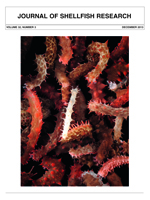Sources of fecal contamination in two shellfish-bearing tidal rivers (Coan and Little Wicomico) adjacent to the lower Chesapeake Bay in Virginia were identified using antibiotic resistance analysis (ARA) and pulsed-field gel electrophoresis (PFGE) on Escherichia coli. Both rivers contained numerous shellfish beds that were closed to harvest as a result of fecal contamination. Host-origin fecal samples (n = 519) were collected and used to build a regional library for each method (8 E. coli isolates per sample for ARA, 4,152 total; 4 isolates per sample for PFGE, 2,076 total). The best classification rule for the host-origin data set was generated by discriminate analysis (nonpooled covariance, jackknife estimates, 80% threshold), and the average rate of correct classification (ARCC) for the libraries was 70.4% for ARA and 83.3% for PFGE. The libraries were challenged for predictive ability with sets of isolates that represented reproducibility, accuracy, and robustness. The libraries were used to classify sources of E. coli isolated monthly for 12 mo (September 2001 to August 2002) from 15 sampling stations in the two rivers (180 total samples), and ARA was performed on 24 E. coli isolates/sample, or 4,320 total isolates (6 isolates per sample for PFGE, or 1,080 total isolates). Humans and birds were identified by both methods as the dominant sources of fecal bacteria in both rivers over all stations and months combined. Although many stations exceeded fecal count standards, rainfall was a factor at only a few stations, and season had little effect. There was a 73.4% and an 80.7% average agreement over sources for the host-origin isolates and water sample isolates, respectively, that were classified by both ARA and PFGE. Disagreement between the two methods was a result of isolates that PFGE, the more sensitive and accurate method, could not identify, whereas ARA placed the same isolates in one of the source categories. Inclusion of the newer DNA-based source tracking methods that do not require cultivation or libraries is described, along with how these methods can provide guidance to confirm the human-origin pollution that was found in the condemned shellfish waters when the study was done. These same waters were still condemned in 2013, and the newer DNA-based methods plus better sampling designs are more likely to help identify the exact locations where such human pollution originates.
How to translate text using browser tools
1 April 2014
Identifying Sources of Fecal Contamination in Shellfish Waters in Two Tidal Rivers
Charles Hagedorn,
Annie Hassall Lawrence,
J. Brooks Crozier
ACCESS THE FULL ARTICLE

Journal of Shellfish Research
Vol. 33 • No. 1
April 2014
Vol. 33 • No. 1
April 2014
antibiotic resistance analysis
fecal coliforms
fecal contamination
pulsed-field gel electrophoresis
shellfish sanitation
water quality




